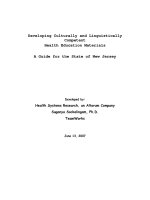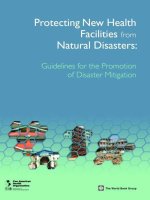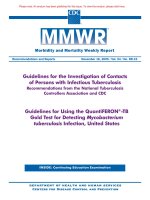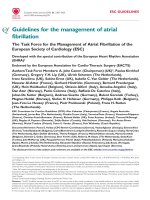Protecting New Health Facilities from Natural Disasters: Guidelines for the Promotion of Disaster Mitigation potx
Bạn đang xem bản rút gọn của tài liệu. Xem và tải ngay bản đầy đủ của tài liệu tại đây (1.15 MB, 53 trang )
Protecting
New Health Facilities
from Natural Disasters:
Guidelines for the Promotion
of Disaster Mitigation
Produced by Tarina García Concheso, based on
Guidelines For Vulnerability Reduction in the Design of New Health Facilities
by R. Boroschek and R. Retamales of the
PAHO/WHO Collaborating Center at the University of Chile
and on the recommendations adopted
at the international meeting “Hospitals in Disasters: Handle with Care,” El Salvador, July 2003.
Area on Emergency Preparedness and Disaster Relief
Washington D.C., 2003
N
D
I
N
A
L
U
T
S
O
R
O
P
S
A
H
O
N
D
I
N
P
E
O
V
I
M
U
P
PAHO Library Cataloguing in Publication:
Pan American Health Organization
Protecting New Health Facilities from Natural Disasters:
Guidelines for the Promotion of Disaster Mitigation
Washington, D.C.: PAHO/World Bank, © 2003.
ISBN 92 75 124841
I Title
1. VULNERABILITY ANALYSIS
2. PREVENTION AND MITIGATION
3. HEALTH INFRASTRUCTURE
4. NATURAL DISASTERS
5. DISASTER PLANNING
NLM HV553.G216r 2003 En
© Pan American Health Organization, 2003
A publication of the Area on Emergency Preparedness and Disaster Relief of the Pan American
Health Organization/World Health Organization in collaboration with the World Bank.
The views expressed, the recommendations made, and the terms employed in this publication do
not necessarily reflect the current criteria or policies of the Pan American Health Organization or
of its Member States.
PAHO and WHO welcome requests for permission to reproduce or translate, in part or in full,
this publication. Applications and inquiries from the Americas should be addressed to the Area on
Emergency Preparedness and Disaster Relief , Pan American Health Organization, 525 Twenty-
third Street, N.W., Washington, D.C. 20037, USA; fax: (202) 775-4578; email: disaster-publica-
This publication has been made possible through the financial support of the World Bank, the
International Humanitarian Assistance Division of the Canadian International Development
Agency (IHA/CIDA), the Office for Foreign Disaster Assistance of the United States Agency for
International Development (OFDA/USAID), and the United Kingdom’s Department for
International Development (DFID).
3
Index
1. Introduction . . . . . . . . . . . . . . . . . . . . . . . . . . . . . . . . . . . . . . . 5
2. Natural Phenomena and Health Infrastructure . . . . . . . . . . . . . 9
3. The Guidelines for Vulnerability Reduction
in the Design of New Health Facilitie
and their incorporation into the Project Cycle . . . . . . . . . . . . 15
3.1 Phase 1: The Pre-investment Phase . . . . . . . . . . . . . . . 18
3.2 Phase 2: The Investment Phase . . . . . . . . . . . . . . . . . . 24
3.3 Phase 3: Operational activities . . . . . . . . . . . . . . . . . . . 31
4 Investment in Mitigation Measures . . . . . . . . . . . . . . . . . . . . .33
5 Policies and Regulations . . . . . . . . . . . . . . . . . . . . . . . . . . . . . .35
6 Training and Education . . . . . . . . . . . . . . . . . . . . . . . . . . . . . 37
7 The Role of International Organizations in the Promotion
and Funding of Mitigation Strategies . . . . . . . . . . . . . . . . . . . 39
Annex I: Effects of natural disasters . . . . . . . . . . . . . . . . . . . . . 43
Annex II: Glossary of Key Terms . . . . . . . . . . . . . . . . . . . . . . . . . 45
References . . . . . . . . . . . . . . . . . . . . . . . . . . . . . . . . . . . . . . . . . . 49
urricanes, floods, earthquakes, landslides and volcanic
eruptions—and the devastation they inflict—are all too
familiar to the countries of Latin America and the
Caribbean. In the last decade, natural disasters have caused more
than 45,000 deaths in the region, left 40 million injured or in need
of assistance, and carried a price tag—in direct damage alone—of
more than US$20 billion.
1
The health sector has proven particularly vulnerable to such havoc.
In the course of the past 20 years, as a result of natural disasters,
more than 100 hospitals and 650 health centers have collapsed or
been so severely damaged that they had to be evacuated. According
to the United Nations Economic Commission for Latin America
and the Caribbean (ECLAC), accumulated losses due to disasters in
the health sector reached US$3.12 billion—the equivalent of 20
countries in the region each suffering the demolition of six hospi-
tals and at least 70 health centers.
2
Approximately 50% of the 15,000 hospitals in Latin America and
the Caribbean are sited in high-risk areas. Many of them lack disas-
ter mitigation programs, emergency plans, or the infrastructure
required to withstand earthquakes, hurricanes, and other natural
phenomena.
5
Introduction
Introduction
1
1 Inter-American Development Bank (IDB), Facing the Challenge of Natural Disasters in Latin America and the Caribbean:
An IDB Action Plan, Washington, D.C., 2002.
2 Pan American Health Organization (PAHO/WHO), Principles of Disaster Mitigation in Health Facilities, Mitigation Series,
Washington, D.C., 2000.
In this context, existing codes and regulations on the design and
construction of health facilities must be revised and reoriented
towards disaster mitigation, with the ultimate goal not only of pro-
tecting the lives of patients, staff and other occupants, but also of
ensuring that such facilities can continue to operate after a disaster
has struck—at the moment when they are most needed. The
knowledge of how to build safe hospitals not only exists, but is
readily available.
One of several efforts to disseminate this knowledge is being active-
ly pursued by the Pan American Health Organization through the
PAHO/WHO Collaborating Center on Disaster Mitigation in
Health Facilities of the University of Chile. With support from the
World Bank and the ProVention Consortium, the Collaborating
Center published the
Guidelines for Vulnerability Reduction in the
Design of New Health Facilities
. These Guidelines were assessed and
validated at the international meeting
Hospitals in Disasters: Handle
with Care
, which was held by PAHO/WHO in El Salvador on 8-
10 July 2003.
It is the aim of this publication to present a summary of the Guide-
lines—emphasizing how they can be used, by whom, and for what
purpose. In addition, some considerations are provided on how to
promote the use of the Guidelines by national authorities, planners
and funding institutions when developing projects for the construc-
tion of new health facilities. Potential users of the Guidelines
include the following:
Initiators of health facility construction projects (who recog-
nize the need for new health facilities):
• The public sector (Ministry of Health, Social Security, etc.)
• The private sector
• Unions
• The military
• Organized civil society
• Municipal governments
*The Guidelines can be accessed at www.paho.org/disasters
6
Protecting New Health Facilities from Natural Disasters
Executors and supervisors of health facility construction
projects:
• The Ministry of Health
• The Ministry of Public Works
• Social Security
• Government offices or independent agencies in charge of
enforcing building standards
• Subcontractors entrusted with hospital management
• Subcontractors entrusted with the management, quality con-
trol, design and/or execution of the project
• The private sector
Financing bodies in charge of funding health facility
construction projects:
• The government
• The public sector bodies that have identified the need for
new facilities
• The Ministry of Finance
• The Ministry of Health in tandem with the Ministry of
Finance
• International sources: development banks and bilateral and
multi-lateral donors
• Nongovernmental organizations
• The private sector (including private banking)
7
Introduction
ral disasters, the impact of these events is disproportionately
higher for developing countries. It is estimated that disaster-
related losses as a ratio of GNP are 20 times greater in devel-
oping than in industrialized nations.
3
Among the effects
of such phenomena, the damage caused to health infra-
structure in Latin America and the Caribbean has been
particularly severe (see Annex I)
.
Hurricanes such as Gilbert (Jamaica, 1988), Luis and
Marilyn (in September 1995, afeccting Antigua and Barbuda,
St. Kitts and Nevis, St. Martin and other islands), Mitch in
Central America (October 1998) as well as the earthquakes that
hit Mexico in 1985, El Salvador in 1986 and 2001, and Costa Rica
and Panama in 1991, caused serious damage to health facilities in
those countries, affecting their capacity to care for the victims of the
disaster (see Table 1)
.
9
2
3 Pan American Health Organization (PAHO/WHO) and U.N. International Decade for Natural Disaster Reduction, Lessons Learned in
Latin America on Disaster Mitigation in Health Facilities: Aspects of Cost-Effectiveness, Washington, D.C., 1997.
Natural Phenomena
and Health Infrastructure
Natural Phenomena and Health Infrastructure
What are the implications of such natural disasters for the health
sector? Some are direct:
• Health facilities are damaged.
• Local infrastructure is damaged, interrupting the basic ser-
vices that are indispensable to the provision of health care,
and blocking or destroying access routes to the facilities.
10
Protecting New Health Facilities from Natural Disasters
Table 1. Health facilities affected by natural disasters
in selected countries of the Americas, 1985–2001.
Source: Proceedings, International Conference on Disaster Mitigation of Health Facilities, Mexico, 1996.
(a) Only health facilities of the Ministry of Health have been listed, not those of Social Security or the private sector.
(b) During its 35 years of operation, Joseph N. France Hospital in Saint Kitts was seriously damaged by hurricanes on 10 separate
occasions.
Data unavailable.
Disaster
Hospitals and
health centers
affected
Hospital beds
out of service
Earthquake, Chile, March 1985 79 3,271
Earthquake, Mexico, September 1985 13 4,387
Earthquake, El Salvador, October 1986 7 1,860
Earthquakes, El Salvador, January and February 2001a 113 2,021
Hurricane Gilbert, Jamaica, September 1988 24 5,085
Hurricane Joan, Costa Rica and Nicaragua, October 1988 4
Hurricane Georges, Dominican Republic, September 1998 87
Hurricane Georges, Saint Kitts and Nevis, September 1998b 1 170
El Niño, Peru, 1997-1998 437
Hurricane Mitch, Honduras, November 1998 78
Hurricane Mitch, Nicaragua, November 1998 108
• An unexpected number of deaths, injuries and illnesses
impact the local community, overwhelming the health
network’s therapeutic response capacity.
Others are indirect:
• Population displacements occur, whether organized or
spontaneous, away from the affected areas towards those
that have not been directly hit, but whose health systems
may not have the capacity to cope with the increased
demand for its services.
• The risk of communicable diseases and mental illness as a
result of the disaster is likely to increase among the affected
population.
• Food supplies may become scarce, threatening the popula-
tion with malnutrition and all its attendant hazards.
• Both remedial and preventive health care services may
become harder or impossible to obtain, or too expensive.
• The supply of safe drinking water may become sporadic or
be totally interrupted, or contamination may occur.
• Health priorities may end up in disarray as public health
campaigns are suspended to meet emergency needs.
Figure 1 presents a summary of the socioeconomic impact of a
disaster on the health sector. The cost of such damage, often hard
to quantify, tends to build up throughout the rehabilitation and
reconstruction period until operational capacity is fully restored.
Damage to assets and services may contribute significantly to the
impoverishment of the population, since they lead to loss of jobs
and livelihoods.
4
Specifically, the vulnerability of hospital facilities to potential haz-
ards involves six major areas:
5
• Buildings: The location and building specifications, particu-
larly regarding design, the resiliency of the materials, and
11
Natural Phenomena and Health Infrastructure
4 Keipi, K. and J. Tyson, Planning and Financial Protection to Survive Disasters, Technical Report Series of the Department of Sustainable
Development, Inter-American Development Bank (IDB),
Washington, D.C., 2002.
5 Pan American Health Organization (PAHO/WHO), Proceedings, International Conference on Disaster Mitigation in Health Facilities,
Mexico, 1996.
physical vulnerability, determine the ability of hospitals to
withstand adverse natural events. The slightest structural or
architectural element that collapses or fails entails both finan-
cial and human costs.
• Patients: It is customary for health facilities to work 24 hours
a day at about 50 percent of their service capacity. Any disas-
ter will inevitably increase the number of potential patients
and amplify their level of risk. Waiting lists get longer, since
it becomes impossible to meet both routine demand and that
generated by the emergency. Patients also suffer from the
decline in the provision of services as a result of damaged,
partially evacuated or non-operational facilities.
• Hospital beds: In the aftermath of a disaster, the availability
of hospital beds frequently decreases even as demand goes up
for emergency care of the injured.
• Medical and support staff: It is hardly necessary to describe
the significant disruption to the care of the injured caused by
the loss of medical or support personnel. In order not to suf-
fer a concomitant loss in response capacity, outside personnel
must be hired temporarily, adding to the overall economic
burden. Sometimes the death of a specialist can entail major
technical costs for the country affected by the disaster.
• Equipment and facilities: Damage to nonstructural elements
(such as equipment, furniture, architectural features, and
medical supplies) can sometimes be so severe as to surpass the
cost of the structural elements themselves. Even when the
damage is less costly, it can still be critical enough to force the
hospital to stop operating.
• Basic lifelines and services: The ability of hospitals to func-
tion relies on lifelines and other basic services such as electri-
cal power, water and sanitation, communications, and waste
management and disposal. It is not a given that self-con-
tained backup emergency services are available at all health
facilities. When a natural disasters affects some of the ser-
vices, the performance of the entire hospital is affected.
12
Protecting New Health Facilities from Natural Disasters
13
Natural Phenomena and Health Infrastructure
Figure 1. Socioeconomic impact of a disaster in the health sector.
• Debris removal
• Restoration of site
• Vulnerability
assessment
• Mitigation and
prevention
measures
• Damage assessment
• Development of repair and
reconstruction projects
• Availability of resources
(financial, human, material)
• Acquisition of equipment,
furnishings and drugs
• Importation of equipment
and drugs
Cost of demolition
and clean-up
Cost of
mitigation
works
Cost of repairs
and replacement
• Water and sanitation
• Sanitary control (food, hygiene and
public health education)
• Anti-vector efforts
• Vaccination
• Epidemiological surveillance
• Laboratory services
COST OF SANITATION
AND EPIDEMIOLOGICAL
INTERVENTIONS
• Evacuation of affected health
facilities
• Interruption of public health and
treatment programs
• Provision of services to population
displaced by disaster (public health,
medical care, mental health)
• Increase in waiting lists
• Fall in stock of drugs and vaccines
• Development and management of
hospital campaign.
OTHER EFFECTS
ON THE PROVISION
OF HEALTH CARE
DISASTER
DISASTER
• Medical care (out- and in-patient)
• Greater demand for drugs and other supplies
• Increase in hours worked by MDs, paramedics
and administrative staff
• Evacuation and/or transport of victims
COST OF TREATING VICTIMS
DAMAGE TO INFRASTRUCTURE,
EQUIPMENT, FURNISHINGS AND SUPPLIES
When it comes to disaster resiliency standards, the bar is inevitably
raised in the case of health facilities, particularly hospitals. It is not
enough for them to remain structurally sound long enough for
non-ambulatory inpatients to survive; instead, these patients must
continue to receive appropriate care even as new patients are com-
ing in as a result of the injuries sustained during the event. It is also
important that health promotion and prevention programs, such as
prenatal care and hemodialysis, not be interrupted. For all these
services to be maintained without interruption, the buildings and
their contents must remain operational and formal disaster
response plans must be in effect.
Hospital authorities, cognizant of the facts outlined above, fre-
quently produce emergency response plans—but such plans often
fail to incorporate prevention and mitigation measures, or to
strengthen the role of hospital disaster committees in risk manage-
ment. Hence the need to incorporate measures for improving gen-
eral safety and, above all, preserving the functionality of key areas
of the hospital when designing and building new health facilities.
These areas include: emergency services, intensive care units, diag-
nostics facilities, the surgical theater, the pharmacy, food and drug
storage areas, and registration and reservation services.
It is important to note that in the countries of Latin America and
the Caribbean many hospitals damaged by natural disasters were
designed in accordance with seismic-, wind-, and flood-resistant
building standards. This suggests that the design of hospitals should
apply even higher standards than those relevant to buildings meant
for housing or offices. Most seismic and flood- or wind-resistant
building codes in the region strive to protect the lives of those
inside the building, not to ensure the continuity of the building’s
operations.
6
Both the architectural and the structural design of
health facilities should consider not only the physical aspects of any
given adverse event, but also the social, economic and human
implications of the functions played by hospitals in a community.
14
Protecting New Health Facilities from Natural Disasters
6 Pan American Health Organization (PAHO/WHO), Principles of Disaster Mitigation in Health Facilities, Mitigation Series,
Washington, D.C,. 2000
The loss of lives and property as a result of earthquakes and other
extreme natural phenomena can be mitigated by applying existing
technologies without incurring enormous financial expense. All
that is required is to have the political and social will to apply
the right techniques.
Since in most communities it takes about two generations
for the current stock of buildings to be replaced, attention
must be paid both to the structural intervention of existing
edifices and to the design and construction of new structures.
At present, not all countries in the region have adopted or imple-
mented the necessary technical standards for the hurricane- or
earthquake-resistant design and construction of new buildings.
This means that significant reductions in risks and potential dam-
age are feasible if preventive measures are incorporated into the
design, construction and maintenance of all new health facilities.
7
In this respect, applying the Guidelines for Vulnerability Reduction
in the Design of New Health Facilities
can play a key role in reduc-
ing existing risks. The section that follows presents a summary of
the
Guidelines and shows how they can be incorporated into the
development cycle of projects for the construction of new health
facilities.
The Guidelines for Vulnerability Reduction
in the Design of New Health Facilities
and Their Incorporation into the
Development of Projects Cycles
3
7 Pan American Health Organization (PAHO/WHO), Principles of Disaster Mitigation in Health Facilities – Volume I: General Issues,
Washington, D.C., 1993.
15
The Guidelines for Vulnerability Reduction in the Design of New Health Facilities
The purpose of the Guidelines is to assist health-sector managers,
professionals and technical consultants involved in the administra-
tion, design, construction or inspection of health facilities so that
mitigation measures are included to reduce vulnerability and ensure
the highest level possible of protection to the facilities and their
operation.
8
Based on the three phases of the traditional project cycle—
pre-investment, investment and operations—the
Guidelines propose a series of critical guiding principles
to facilitate the incorporation of vulnerability reduc-
tion mechanisms into the project. The
Guidelines
specify clearly which activities must be carried
out at each stage in order to incorporate miti-
gation measures, and provide tools for their
incorporation.
Figure 2 shows the project cycle for the con-
struction of new health facilities, with its three
phases and corresponding stages, which serve as the
framework for the recommendations contained in the
Guidelines. The following sections have been structured
according to these phases and stages, specifying recom-
mendations in each case.
16
8 The Guidelines cover natural hazards such as earthquakes, hurricanes, strong winds, landslides, debris and mudflows, floods and volcanic
activity, excluding other phenomena such as fires or other man-made hazards.
Protecting New Health Facilities from Natural Disasters
17
The Guidelines for Vulnerability Reduction in the Design of New Health Facilities
Figure 2. The project cycle in the design of health facilities.
PHASE 1
Pre-investment activities
I. Needs Assessment
II. Options Assessment
III. Preliminary Project
PHASE 2
Investment activities
IV. Project Design V. Construction
PHASE 3
Operational activities
VI. Operations and maintenance
18
Protecting New Health Facilities from Natural Disasters
3.1 Phase 1: Pre-investment
PHASE 1
Pre-investment activities
I. Needs Assessment
II. Options Assessment
III. Preliminary Project
Stage I: Needs assessment
At this stage, an assessment is made regarding the need for a new
health facility. Relevant variables include: the characteristics of the
existing health-care network, its development policies, the rate of
use of the existing services, expected future demand, epidemiologic
and demographic profiles, health policies, and geographic charac-
teristics. The funding for the development of the new health faci-
lity must be secured at this stage.
Mitigation measure:
Defining the protection objectives of the new facility.
The effects of an adverse natural phenomenon on a health facility
may include (a) panic, injuries and/or deaths among the patients
and personnel, (b) partial or total damage to the structure, and (c)
loss of the facility’s operational capacity, and hence its capacity to
meet the health care needs of the community when they are most
pressing.
The prevention of each of these consequences depends on the
per-
formance objective
that is set a priori for the facility. The first,
most basic performance objective is known as
life safety, and is the
minimum prerequisite for any kind of infrastructure. The second is
19
known as investment protection, and essentially involves the pro-
tection of the infrastructure and equipment. The third performance
objective is the most desirable, that is,
operational protection. It is
meant to ensure that the health facility can continue to operate
after a disaster has struck.
At this preliminary stage of the project it will be necessary to define
the overall performance objective that would be desirable, as well as
feasible, for the intended facility, based on the various hazards
prevalent in the region and the likely degree of severity of these haz-
ards. The
Guidelines include a tool for assisting decision-makers to
determine what kind of response the planned health facility will be
capable of, depending on the severity of an event and the protec-
tion objective chosen.
It should be borne in mind that, while current technological
advances and changes in design philosophy, along with
improvements in quality assurance procedures for the con-
struction and maintenance of infrastructure can limit the
damage and ensure almost certain operational continuity,
it will not always be feasible to do so. In many
instances there will be restrictions of various kinds:
technical or natural (for example, the need for a health
facility on an island with significant volcanic activity),
economic (for example, achieving a balance between the
need to expand the health care system in order to meet
health goals, and the need to ensure the safety of the facilities),
or political (when infrastructure is developed and located based
on the expectations of a given constituency).
In situations in which the available resources do not make it possi-
ble to set the optimum protection objective for the facility as a
whole, the
Guidelines suggest alternatively that priority be given to
critical services when choosing their location and resistance to the
impact of disasters. As such, a facility may consist of two different
areas: one where critical services are located, built in such a way that
it meets operational protection objectives (i.e., which can continue
The Guidelines for Vulnerability Reduction in the Design of New Health Facilities
20
Protecting New Health Facilities from Natural Disasters
to function after a disaster), and another one housing less critical
services, with lower protection standards.
The exercise of setting the performance objectives for the intended
facility (or parts of the facility) should identify specific needs in
terms of organization, safety, and damage control of infrastructural
components, and should also state clear requirements regarding the
characteristics of the site where the health facility will be built, as
well as the infrastructure that will be involved.
Stage II: Assessment of site options
This stage involves the identification, evaluation and comparison of
the various options for locating the intended health facility in order
to meet the health care needs of the population, based on criteria
such as public health policies, demographic data, and the geograph-
ical, sociopolitical and economic considerations considered perti-
nent by the client institution. The definitive site of the facility will
be the outcome of this multiple assessment process.
Mitigation measure: Choosing a safe site
for the new facility based on general criteria
and an assessment of the existing risks from natural hazards
When assessing the available options for the site of the intended
health facility, attention must be paid to performance objectives set
for the facility at normal times and during emergencies, the com-
parative analysis of the natural and technological hazards present at
the potential sites, the estimated cost and technical feasibility of
implementing the necessary protection systems, the economic re-
sources available, and a cost/benefit analysis of the options.
This assessment must cover not only the specific sites but also their
surroundings. The way in which natural phenomena affect the sur-
21
The Guidelines for Vulnerability Reduction in the Design of New Health Facilities
rounding population, the population of reference and the relevant
infrastructure must all be evaluated, particularly their impact on life-
lines and access roads that allow a facility to meet its objective.
In short, when looking at potential sites for a new health facility,
the following variables all come into play:
• Health care needs and public health requirements;
• Sociopolitical and cultural considerations;
• Technological hazards;
• Natural hazards;
• Mitigation or risk management requirements (including
existing technology for hazard reduction and its cost);
• Performance objectives in normal times;
• Performance objectives during emergencies;
• Characteristics of the health care network;
• Socioeconomic restrictions;
• Technical restrictions; and
• Political and social restrictions.
Once the potential site options have been identified, it will be nec-
essary to evaluate each on the basis of historical and other data as
well as preliminary studies of the variables mentioned above.
Special attention should be paid to the natural hazards prevalent at
each site. In the case of each specific hazard, attention must be paid
to (i) the technical and financial feasibility of implementing protec-
tion systems for the facility as a whole (prevention and mitigation);
(ii) the potential impact on the client population, on lifelines, relat-
ed services, and access to health care services; and (iii) the potential
impact on the region’s or country’s health care network.
22
Protecting New Health Facilities from Natural Disasters
In the end, the selection of the site for the new health facility
should be based on which of the options offers the best mix of safe-
ty vis-à-vis prevailing hazards and levels of risk and accessibility, in
terms of the supply and demand of health care services and the
cost-effectiveness of the site chosen.
There may be times when the desired performance objective cannot
be met due to the extreme conditions of vulnerability confronting
the target population or because the cost of achieving the desired
level of protection would be prohibitive. Since the health care needs
of such settlements cannot simply be ignored, decisions about loca-
tion should contemplate the following measures:
• Distributing the intended functions of the facility so that
they are carried out in locations that are remote from one
another;
• Procuring mobile or temporary facilities, such as field hospi-
tals, and deploying them in the relevant areas;
• Producing effective referral systems so that the population
can easily be transferred to health facilities in other areas.
A key aspect of quality assurance, especially in the case of health
facilities with high protection requirements, is the selection of expe-
rienced professional teams who are active and up-to-date in the
field. During the preliminary stage of the project, including the
hazard and risk assessments, a wide spectrum of professionals will
be required, including urban developers, architects, topographers,
geologists, specialists in soil mechanics, meteorologists, hydrolo-
gists, seismologists, and volcanologists, not to mention hydraulic,
wind, seismic, and structural engineers. The specialists in charge of
vulnerability and risk assessments must have plenty of experience,
preferably in the design of health infrastructure.
The medical and architectural program’s requirements must be
interpreted correctly during the preliminary project stage in order
to choose the right shapes and solutions to existing hazards. It is
essential that the group in charge of this stage of the process have
the required experience.
3.2 Phase 2: The Investment
Stage IV: Project Design
This is the stage at which the technical specifications, plans, budget
and tender documents are produced.
The design stage involves four key actors:
• The
client institution, which sets the goals and require-
ments for the project;
• The
execution team, which carries out the various tasks
required at each stage;
• The
reviewing team, whose job is quality assurance in fulfill-
ment of the project goals and the needs of the client institu-
tion;
• The
financial agency, which procures the funding for the
project and often supervises its execution.
During this and the following stages, the oversight function of the
working teams will be crucial. The contribution by mitigation
24
PHASE 2
Investment activities
IV. Project Design V. Construction
Protecting New Health Facilities from Natural Disasters
25
The Guidelines for Vulnerability Reduction in the Design of New Health Facilities
experts is also essential, and they must coordinate their efforts with
all the other professionals involved in the project. Ideally, all basic
stakeholders (the client institution, the execution team, the review-
ing team and the financial agency) should remain watchful regarding
the fulfillment of the safety and mitigation requirements.
It is also worth noting that in some countries, independent agencies
entrusted with ensuring compliance with existing standards of safety
and quality, sometimes called “quality-control bureaus”, play a criti-
cal watchdog role in the project from this stage on. Since they spe-
cialize in the application of risk reduction principles, such indepen-
dent agencies can ensure that the project meets all relevant quality
standards in the face of the various hazards prevalent on site. The
Guidelines recommend that the design of the project be overseen by
independent specialists—either quality-control bureaus, where they
exist, or else by consultants hired for that purpose—in order to guar-
antee the highest possible standards of quality in the design of the
planned health facility.
In the course of any construction project, its components are typical-
ly divided into two categories:
• The structural elements—all those essential elements that
determine the overall safety of the system, such as beams,
columns, slabs, load-bearing walls, braces, or foundations.
Structural elements comprise a building’s resistance system.
• The
nonstructural elements—all those other elements that,
without forming part of the resistance systems, ultimately
enable the facility to operate. They include architectural ele-
ments (non-load-bearing walls, floor coverings, ceilings, and
other coverings or finishes); equipment and contents
(electromechanical systems, medical and laboratory equip-
ment, furnishings), and services or lifelines. In the case of
hospitals, nearly 80 percent of the total cost of the facility is
due to nonstructural components.









